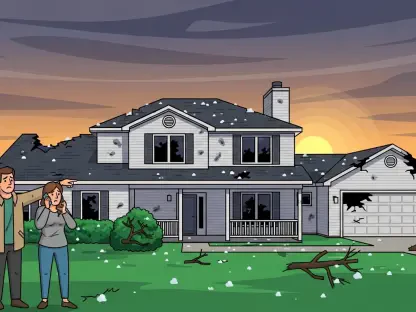The ongoing insurance issues faced by Florida condominium associations have reached a critical point, severely impacting the financial flexibility of many residents. One significant consequence is the restricted ability to refinance mortgages, a problem that has grown in complexity due to Fannie Mae’s expanding “blacklist.” This list includes condo associations that fail to meet the stringent insurance requirements set forth by the federal mortgage guarantor, consequently affecting the refinancing and repair funding options available to residents. The origins of the crisis trace back to the disaster at Champlain Towers South in Surfside, which prompted increased scrutiny on insurance adequacy for condominiums. Despite legislative strides towards ensuring that associations maintain proper insurance and financial reserves for necessary repairs, a gap persists between what is considered adequate by Fannie Mae and what associations can realistically achieve.
Legislative Efforts and Insurance Mandates
In the wake of the Champlain Towers South collapse, Florida legislators introduced new laws aimed at strengthening the insurance framework for condo associations. These regulations established different options regarding the insurance levels considered acceptable, aimed at protecting associations from prohibitive insurance expenses while ensuring adequate coverage. Associations, with the guidance of insurance consultants, have been tasked to find a balance—one where their coverage levels are both financially viable and sufficiently protective against risks. However, the core challenge remains with Fannie Mae’s insistence on full replacement value coverage, a standard that many associations, particularly those managing older properties, find nearly impossible to meet. For properties facing structural challenges or with antiquated features, securing insurance that satisfies both legislative requirements and federal mortgage guarantors’ standards presents a significant hurdle.
The Impact on Condo Owners and Refinancing
Many condo owners, like Dave Mayers, find themselves directly affected by this insurance deadlock. Mayers’ attempt to refinance his mortgage, which would have helped him save substantial funds, was thwarted due to his condo association’s inability to meet Fannie Mae’s insurance criteria. Such individual experiences highlight a wider, systemic problem: even when legislative frameworks offer the notion of acceptable coverage, they often fall short of meeting the full replacement value demands set by financial institutions. Consequently, numerous associations, hampered by non-compliance, remain unable to secure the necessary insurance that would unlock refinancing options under these federally-backed mortgage programs. These financial strains have wider implications, leading to decreased property values and heightened financial tensions among condo owners, particularly impacting those on fixed incomes or facing retirement.
Stakeholder Perspectives and Proposed Adjustments
The perspectives surrounding this issue vary, with some stakeholders advocating for a re-evaluation of insurance mandates. Senator Jennifer Bradley, who spearheaded the legislation, has advocated for a middle ground that doesn’t burden condo associations with unattainable insurance demands. Conversely, voices like Andy Kasten’s highlight the perils of underinsurance, suggesting that anything less than full replacement coverage could result in inadequate rebuilding capability in the event of disasters. Representative Vicki Lopez has suggested that financial institutions such as Fannie Mae reconsider their strict insurance standards, arguing their requirements are excessive in light of the rarity of total structural losses. Lopez has also expressed intentions to work with federal lawmakers to engage entities like Fannie Mae and Freddie Mac in revising these directives, which she argues unduly constrain condo owners across Florida.
The Evolving Insurance Market and Its Challenges
While some improvements in the Florida condo insurance market have been noted, substantial challenges remain, particularly for associations managing properties with structural deficiencies or outdated components. Recent market shifts, however, have unveiled broader coverage options and somewhat stabilized costs that had previously been exorbitant. Nevertheless, associations with aging structural elements, such as outdated roofs, continue to confront difficulties in obtaining comprehensive insurance. This scenario embodies a paradox wherein legislative leniency in insurance coverage conflicts with the high demands of financial institutions. For many associations, pre-existing conditions severely hinder their ability to meet these demands, as they are also required to address structural integrity through state assessments, placing further strain on their financial resources.
Legal Insights and Broader Implications
Experts suggest that condominium associations strive for full replacement insurance wherever feasible, as policies covering only cash value often leave significant financial gaps during emergencies. Attorney Michael J. Gelfand emphasizes that depreciation can diminish the financial help obtainable through insurance claims if only the property’s cash value is insured. This situation creates financial vulnerability for associations when rapid access to large funds becomes necessary. Legal experts have flagged over 1,438 Florida condo associations on a blacklist primarily due to insurance concerns. As attorney Jake Marcus explains, these circumstances signal a troubling trend that might prompt similar insurance issues in other regions. This raises questions about potential policy shifts that could address this growing challenge, aiming to harmonize condo associations’ needs with stringent financial regulations.
Call for Continued Legislative Action
Despite previous legislation being a move in the right direction, the juxtaposition between state provisions and federal financial regulations leaves condo owners and associations in a precarious situation. The challenge of ensuring suitable insurance compliance amidst rigid requirements and an evolving market remains formidable. It necessitates ongoing attention from state legislators and possible federal intervention to streamline and reconcile these conflicting expectations. A united effort may provide meaningful progress toward safeguarding condo owners’ interests across Florida. Such measures could offer more stable refinancing options and, ultimately, preserve the economic health of affected communities. The existing mismatch demands strategic public policies that can adapt to changes while safeguarding the financial resilience of condo owners and their associations.









